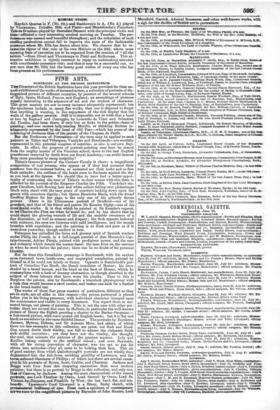FIVE ARTS..
PORTRAITS AT THE BRITISH INSTITUTIONt
TilltDirectors of the British Ihstitutionthave this year provided fbr-their an- until -exhibitiotrof the works of deoeased'artists, a collection of portraits of dis- tinguished persons of-different countries, by_painters of the severer schools- of Italy, Spain, Holland, Franc,e, and' England; an assemblage- of pictures' eqrMlly interesting to the admirers oft art and the student of character. The--great masters are not in every instance adequately represented; but the speciarens include_ so many fine works, that one is disposed to forget that anything is wanting, in the-enjoyment of the rich display that the walls of the gallery present Stiff itis impossible not to wish that a head or two by Raphael and Correggim by Leonardo da Vinci and Sebastian del Piombo, had been- there, if only lcout,- as links in the golden. chahrof pair:ding:, and-one- cannot help-missing Marine, or thinking Rubens in- adminately,repreeenteel: by,the- head of Old Parr-which has mormof the-- colbaring.of? Jordaerts-than-of the painter of the,Chapeau de Paine. But the_ Professors- of- Portraiture-if the term may be applied to-such painters as Titian and-Vgasquez, Vandyke and Rembrandt--are worthily represented in thia pictorial congress of notables; as also is ourown Rey- nolds, In effect, the progress of portrait-painting may here be traced from the miglity.master, of the Venetian school, down to the last English practitioner -removed by death from-our Royal Academy,-an awful descent from stern grandeur to smug insipidity!
Titian's-famous--picture-of the-COrnaro Family -is there: a- magnificent composition of real persons, who appear- as if they had assumed their positions but' the-moment-before, so animated are their looks and so free their attitudes: the outlines of the heads seem to fluctuate against the sky as you look at-the figures. We should like to have had a better oppor- tunity of contrasting the tone of Titian's in-door scenes with this than• is afforded-by-his portrait ofthe Emperor Charles the Fifth. Vandyke's ele- gant Cavaliers, with flowing hair and white collars falling over picturesque black suits, stand with the easy grace of courtiers looking down upon the gazers with conscious dignity; but Queen Henrietta Maria, with the dwarf Geoffrey Hudson for her page, is the only one of his princely dames present. There is his Titianesque portrait of Strafford-one of his grandest, and that of his friend and patron Sir Kenelm Digbp-one of his most 'genial works. It is that which he painted at Sir Keuelm's request, to lee• Charles-the ,First see what he could do; and he has shown that he could depict the glowing warmth of life and the amiable sweetness of a fine disposition, as well as armour and-drapery: the flesh appears bedewed with moisture, the eyes-are lustrous with mild intelligence, and the mouth breathes with expression; and the painting is as fresh and pure as if it wermclone yesterday, though mellow in tone.
Velasquez has embodied the fierce and gloomy spirit of Spanish warfare under Philip the Fourth, in a full-length portrait of that Monarch's Cap- taiw-General, AdriAn- Pareja, painted with prodigious power, and the ease and certainty which denote the master-hand: the man lives on the canvass as when he stood before the painter; there can be no doubt of his personal identity.-
Not far front this fdrmidabIe personage is Rembrandt, with his sunken eyest furrowed brow; bottle-nose; and empurpled complexion, painted by himself as if he could not falsify or flatter. Opposite is Rembrandes por- trait of Cornelius Van Hooft, the Dutch translator of Homer; his brow shaded by a broad bonnek and'his hand on the bust of Homer, which he contemplates with a-look-of dreamy-abstraction, as though absorbed in the subject of those labours that have worn his cheeks. Near to this is Berghem the painter, also by Rembmndt: a truculent- physiognomy with a look that would become-a: steel corslet, and-makes onedook for a feather in the broad-leafed hat.
The works of these four great masters of portraiture, different as they are-in style, are all shire in this, respect-the person portrayed is placed before you in himliving presence, with individual character stamped upon the countenance-and-visible in-every-lineament. You regard them as ani- mated beings, not pieces of painting. This is not the case with other por- ta:aits4 there are, several fine ones byHolbein; in particular the well-known picture of Henry- the- Eighth granting a charter to the Barber-Surgeons,- a fine-toned, picture, with-some-quaint old English heads; but it is flat and hard,--as-areothershy-the samefaithful limner. The portraits-by Zuechero, Janssen, Mytens, Dobson, and Sir Antonio More and others, of which there are fine examples -in this- collection, are paint; not flesh and blood. One. cannot doubt their fidelity, nor fail to admire the elaborate finish an skilful execution ; yet they have not the vitality, the thought, the-soul, that animate the pictures of the greatest masters. Lely and Smeller, belong- entirely to the artificial school ; and even Reynolds, with all his strong perception of character, was too apt to put his sitters into attitudes-they all seem to be looking their best. This air of good society from which Qsinsborough's portraits are not wholly free, degenerated into the fulbdress, smirking gentility of Lawrence, and the tame; softener:I.-blandness of Phillips; of which last there are several exam- ple* in his portraits of Byron, Scott, Crabbe, and Chantrey. Jackson and Briggs were freer from this simpering mannerism than most modern painters; but there is no portrait by Briggs in this collection, and only one, that of Canova, by •Jackson. Among the-most characteristic of the recent pOrtraitt, are-Lord Thurlow-by Oweni Lord Stowell- by Owen, Lord St. Theent by wHoppnek and Franklin by West; the last hard, flat, and tea- boardy. Lawrence's Lord Liverpool is a flimsy, flashy sketch, with Prete:natural bra:lie:Roy:0f eyed From such a specimen of contemporary salve-turn to the magnifibent pictures by Reynolds of John Hunter, Lord Mansfield, Garrick, Admiral Boseavren; and other well-known works, with a sigh for-the-decline of'British art, in portraiture-


























 Previous page
Previous page